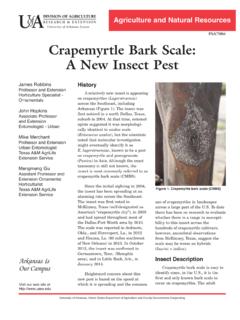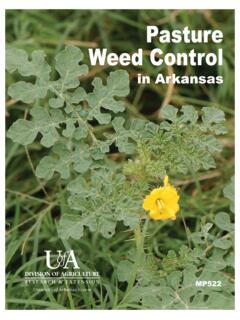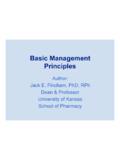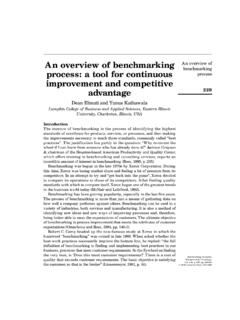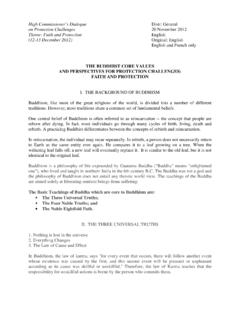Transcription of Fecal Egg Counting for Sheep and Goat Producers - FSA9608
1 Animal ScienceCooperative Extension Program FSA9608 University of Arkansas at Pine Bluff Fecal Egg Counting for Sheep and goat Producers David Fernandez Extension Livestock Specialist Introduction A Fecal egg count (FEC) is a simple procedure you can perform at home to get an approximation of the parasite load your Sheep or goats are carrying. You can also use the FEC to find out if your dewormer is still effective or if the gastrointestinal parasites in your herd or flock have become resistant to it. How to Conduct a Fecal Egg Count To conduct a Fecal egg count, you will need a few items, most of which you can find around the house. You will need: Small disposable cups Marker Small bowl Tea strainer Craft (popsicle) sticks Sugar Pitcher 30 cc syringe 3 cc syringe Gram scale Disposable exam gloves Obstetrical lubricant Eye dropper McMaster egg Counting slide Microscope The microscope need not be expensive.
2 Microscopes capable of 100x magnification can be purchased for less than $100. You should look for a 10x wide field lens and a bright light source. Dissecting microscopes cannot be used for FEC. McMaster egg Counting slides are available for $15 each ( ). Wash the slide well just before you load it with your sample solution, as the damp slide will more easily fill with the sample. Label each small cup with the number of the animal from which you will collect some feces. You may be able to collect fresh feces if you see the animal defecate. Otherwise, use an exam glove and lubricate the index finger. Insert your finger into the rectum of the goat or Sheep and gently remove about 8-10 Fecal pellets and place them in the cup.
3 You will only need 2 grams of feces, so this will ensure you have plenty. Mix 5 parts sugar to 4 parts water to make your sugar solution. An easy measurement is 1 cups of sugar in 1 cup of water. It may take some time and a little heating to get the sugar to dissolve completely. If you have a gram scale, weigh out 2 grams of feces for each animal and discard the rest. If you do not have a gram scale, use a 3 cc syringe and pack 2 cc (2 ml) of feces into the syringe to approximate 2 grams. You can cut the tip of the syringe off to make it easier to get the feces out of the syringe once you have measured the sample. Remember to keep each animal s sample separate.
4 Place the feces in the tea strainer and put the tea strainer in the small bowl. Use the 30 cc syringe to measure 28 cc (or ml) of the sugar water solution and add it to the bowl. University of Arkansas at Pine Bluff, United States Department of Agriculture, and County Governments Cooperating Crush the Fecal pellets in the tea strainer with a craft stick so that they begin to dissolve in the sugar water solution. The tea strainer will keep the larger fibrous particles from getting into your sample so you can see the parasite eggs better under the micro scope. Make sure the Fecal pellets dissolve as com pletely as possible, without getting too much fiber in the final sample.
5 Remove the tea strainer and discard the fibrous material that remains in it. Stir the sugar water/ Fecal solution with your craft stick to thoroughly mix the sample. While the solution is still swirling, use the eye dropper to collect some of the fluid. Gently but quickly squeeze the fluid onto the McMaster egg Counting slide. The fluid should move fairly easily and evenly across the chamber of the slide. Repeat the procedure, including stirring the sugar water/ Fecal sample and load the second chamber. Determining Parasite Load The McMaster egg Counting slide has two chambers, each of which has a grid etched into the surface of the slide (Figure 1). FIGURE 1.
6 McMaster egg Counting slide. Allow the sugar water/ Fecal sample to settle briefly (about 5 minutes). You may use this time to prepare the next sample for Counting . Use the 4x or 10x objective (lens) and count the parasite eggs you see that are in the grid area. Start by focusing the microscope on the air bubbles (Figure 2). Air bubbles FIGURE 2. Air bubbles are round, bright in the middle and dark around the edges. Parasite eggs areoval, dark in the middle and lighter around the edges. FIGURE 3. Notice the gridlines marked by the arrows in the photo. Too much fibrous material or adim light source can make finding the gridlines difficult. Notice also the parasite egg that falls out side the grid box.
7 This egg should not be counted to determine your Fecal egg count total. will float at the same level as the parasite eggs, but they are easier to find. Air bubbles are round and will be dark around the edges and bright in the middle. Parasite eggs will be oval and lighter around the edges and darker in the middle. You may want to use a clicker counter (available for under $20) to keep track of your count. Do not include eggs that are outside the gridlines of the slide or you will over-count the number of eggs. There are usually two knobs beneath the stage where the slide rests. These knobs allow you to move the slide up and down and from side to side slowly so you can get an accurate count.
8 The gridlines on the slide can often be difficult to see in samples that contain too much fibrous material or if the microscope s light bulb needs to be replaced (Figure 3). Write down the animal number and number of eggs in the Fecal sample. Add the number of eggs counted in each chamber together and multiply the total by 50. This will give you the number of eggs per gram of feces in your Sheep or goat . For example: Animal ID Eggs inChamber 1 Eggs inChamber 2 Calculation Total 101 20 23 (20 + 23) x50 2150 eggs per gram 103 18 15 (18 + 15) x50 1650 eggs per gram Fecal Egg Count Reduction Test The Fecal Egg Count Reduction Test (FECRT) is a way to measure how effective your dewormer is.
9 Gather a sample of Sheep or goats from your herd or flock. Six animals are enough, but 10-12 are better because animals react differently to the dewormer. Collect a Fecal sample from each animal, then treat the animals with your dewormer as you normally would. Count the number of parasite eggs in the Fecal samples and record the numbers where you will not lose them. Two weeks after you have dewormed your sample animals, collect a Fecal sample from the same animals and count the eggs again. Subtract the num ber of eggs in the second sample from each animal from the number of eggs in the first sample from each animal and divide the number by the number of eggs in the first sample.
10 Multiply the result by 100 to get the percent of worms killed. For example, Animal ID Sample1 Sample2 Difference Percent kill 101 2500 250 2250 2250 2500 x 100 = 90% 203 1900 300 1600 1600 1900 x 100 = 84% 155 2450 450 2000 2000 2450 x 100 = 82% The average percent kill would be (90 + 84 + 82) 3 = 85%. What to Do With Your Results Fecal egg counts alone will give you some idea of the level of parasite infection your animals are carry ing. But some internal parasitic worms produce many more eggs than others. In Sheep and goats the gastro intestinal parasite of primary concern is the Barber Pole worm (Haemonchus contortus). During the warmer parts of the year, and if the Barber Pole worm is prevalent on your farm, you should deworm your dry does, dry ewes, bucks and rams when the Fecal egg count goes above 2,000 eggs per gram.






